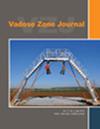Water vapor transport through bioenergy grass residues and its effects on soil water evaporation
IF 2.8
3区 地球科学
Q3 ENVIRONMENTAL SCIENCES
引用次数: 0
Abstract
Abstract Miscanthus is a productive perennial grass that is suitable as a bioenergy crop in “marginal” lands (e.g., eroded soils) with low water holding capacity. However, little is known about the impact of miscanthus residues on vapor transport and soil water budgets. Laboratory experiments were conducted to measure the vapor conductance through miscanthus residues and its effect on soil water evaporation. The ranges for the length, width, and thickness of residue elements were 0.5–9.0, 0.1–0.5, and 0.1–0.5 cm, respectively. Average residue areal, bulk, and skeletal densities were 0.88 kg m −2 , 24 kg m −3 , and 1006 kg m −3 , respectively, giving a porosity of 0.98 m 3 m −3 . A power function described the decrease in conductance with increasing residue load. The corresponding conductance for a residue load of 0.88 kg m −2 was 1.6 mm s −1 . During the first days of a 60‐day drying experiment, cumulative evaporation showed logarithmic decay with increasing residue load. Conversely, cumulative evaporation during the last days of the study showed little difference between treatments. Measurements indicated that there is a “critical” residue load (∼1.0 kg m −2 ) beyond which evaporation no longer decreases appreciably when the soil is under the stage 1 evaporation regime. Results suggest that soil water conservation in marginal lands may be accomplished by maintaining moderate amounts of bioenergy grass residue covering the soil. Determining “critical” loads for different residue types is a knowledge gap that merits further research.生物质秸秆的水汽输送及其对土壤水分蒸发的影响
芒草是一种多产的多年生草本植物,适合作为生物能源作物在“边缘”土地(如水土流失土壤)低持水能力。然而,对芒草残茬对土壤水汽输送和水分收支的影响知之甚少。通过室内试验,测定了芒草残渣的蒸汽导率及其对土壤水分蒸发的影响。残基的长度为0.5 ~ 9.0 cm,宽度为0.1 ~ 0.5 cm,厚度为0.1 ~ 0.5 cm。平均残留面积、体积和骨架密度分别为0.88 kg m - 2、24 kg m - 3和1006 kg m - 3,孔隙率为0.98 m - 3。幂函数描述了电导随剩余负载的增加而减小。当残余负载为0.88 kg m−2时,相应的电导为1.6 mm s−1。在60天干燥试验的头几天,累积蒸发量随残留物负荷的增加呈对数衰减。相反,研究最后几天的累积蒸发量在处理之间几乎没有差异。测量表明,当土壤处于第1阶段蒸发状态时,存在一个“临界”残留负荷(~ 1.0 kg m - 2),超过这个负荷,蒸发不再明显减少。结果表明,在边缘土地上保持适量的生物质秸秆覆盖土壤可以实现水土保持。确定不同残留物类型的“临界”负荷是一个值得进一步研究的知识缺口。
本文章由计算机程序翻译,如有差异,请以英文原文为准。
求助全文
约1分钟内获得全文
求助全文
来源期刊

Vadose Zone Journal
环境科学-环境科学
CiteScore
5.60
自引率
7.10%
发文量
61
审稿时长
3.8 months
期刊介绍:
Vadose Zone Journal is a unique publication outlet for interdisciplinary research and assessment of the vadose zone, the portion of the Critical Zone that comprises the Earth’s critical living surface down to groundwater. It is a peer-reviewed, international journal publishing reviews, original research, and special sections across a wide range of disciplines. Vadose Zone Journal reports fundamental and applied research from disciplinary and multidisciplinary investigations, including assessment and policy analyses, of the mostly unsaturated zone between the soil surface and the groundwater table. The goal is to disseminate information to facilitate science-based decision-making and sustainable management of the vadose zone. Examples of topic areas suitable for VZJ are variably saturated fluid flow, heat and solute transport in granular and fractured media, flow processes in the capillary fringe at or near the water table, water table management, regional and global climate change impacts on the vadose zone, carbon sequestration, design and performance of waste disposal facilities, long-term stewardship of contaminated sites in the vadose zone, biogeochemical transformation processes, microbial processes in shallow and deep formations, bioremediation, and the fate and transport of radionuclides, inorganic and organic chemicals, colloids, viruses, and microorganisms. Articles in VZJ also address yet-to-be-resolved issues, such as how to quantify heterogeneity of subsurface processes and properties, and how to couple physical, chemical, and biological processes across a range of spatial scales from the molecular to the global.
 求助内容:
求助内容: 应助结果提醒方式:
应助结果提醒方式:


